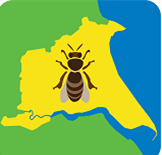Clothing choices

You’re never going to make a fashion statement in a bee suit. Practical, rather than smart or classy, they’re essential kit for keeping bees. YouTube hosts videos from beekeepers without protection, but going bare-skinned isn’t recommended for beginners. One sting can result in a short, sharp pain but multiple stings can be serious, even for those without an allergy. The best advice is to cover up as much as possible, at least in the early days.
Clothing is down to personal choice but I didn’t know where to start. Informed choices require knowledge. Only wearing bee clothes determines how suitable they are. What works for one might not work for another, so some trial and error is to be expected.
One thing to bear in mind is the majority of inspections take place in the summer when it’s likely to be hot. What’s worn underneath the suit is almost as important because – honestly – you’re going to sweat. You’ll need something to hold back long hair as it’s not possible to push strands out of your eyes or even clear perspiration. As for wiping a runny nose or dealing with a sneeze, be prepared for some veil cleaning afterwards.

If possible, trying out a borrowed suit is a useful starting point. My first purchased suit is a bit too long and wide, but that feels better than being too short or small. Anything which is tight to the skin will be easier for a bee sting to penetrate. You’re going to get stung at some point but can take steps to prevent the entry point being too easy. If your bum looks big in your suit, it’s probably too close to your skin. Also, the looser the fabric, the better the chance of staying cool when the temperature rises. Inspections are best when the bees are flying and they love the sun.
If money is limited, mid-price gear is a good start. Avoid cheap. It’s less about the fabric (although cheaper suits can also be sweaty suits) and more about the quality of zips and other fasteners, ease of access when getting changed, and things like having handy pockets. Hoods and veils vary with size and price, with different types having different degrees of visibility. Looking down with ease is an important consideration but again, this will ultimately come down to personal preference, based on experience.
Clothing is mainly about avoiding gaps. Wellies are good for protecting feet although they’ll get hot. Thick leather-type gloves, often sold with bee suit kits, will help avoid stings but can be difficult to work with when dexterity is needed. Nitrile gloves are popular and there’s the option of using a double layer if nerves are an issue.
Research bee seller open days or other sale promotions and remember trying before buying is essential. Asking around for advice can help but, as with all bee-shaped guidance, there’ll be many different answers. Like everything to do with getting started, clothing is a case of live and learn. Wearing protective gear really is the best way to find out what works best.
It’s likely the first suit won’t be your final choice of fabric and design. However, investing in a second one is never money wasted. If you’re keeping bees in a public space like an allotment there’s likely to be a lot of interest. Fellow plotters unaccustomed to beekeeping won’t always appreciate the value of covering up so a spare suit, or at least a hat and veil plus gloves, can be valuable kit for those determined to get a closer look at your new acquisitions.
After all, visitors will know you’re there. The one thing a beekeeper in full protective gear can’t do is be invisible.


